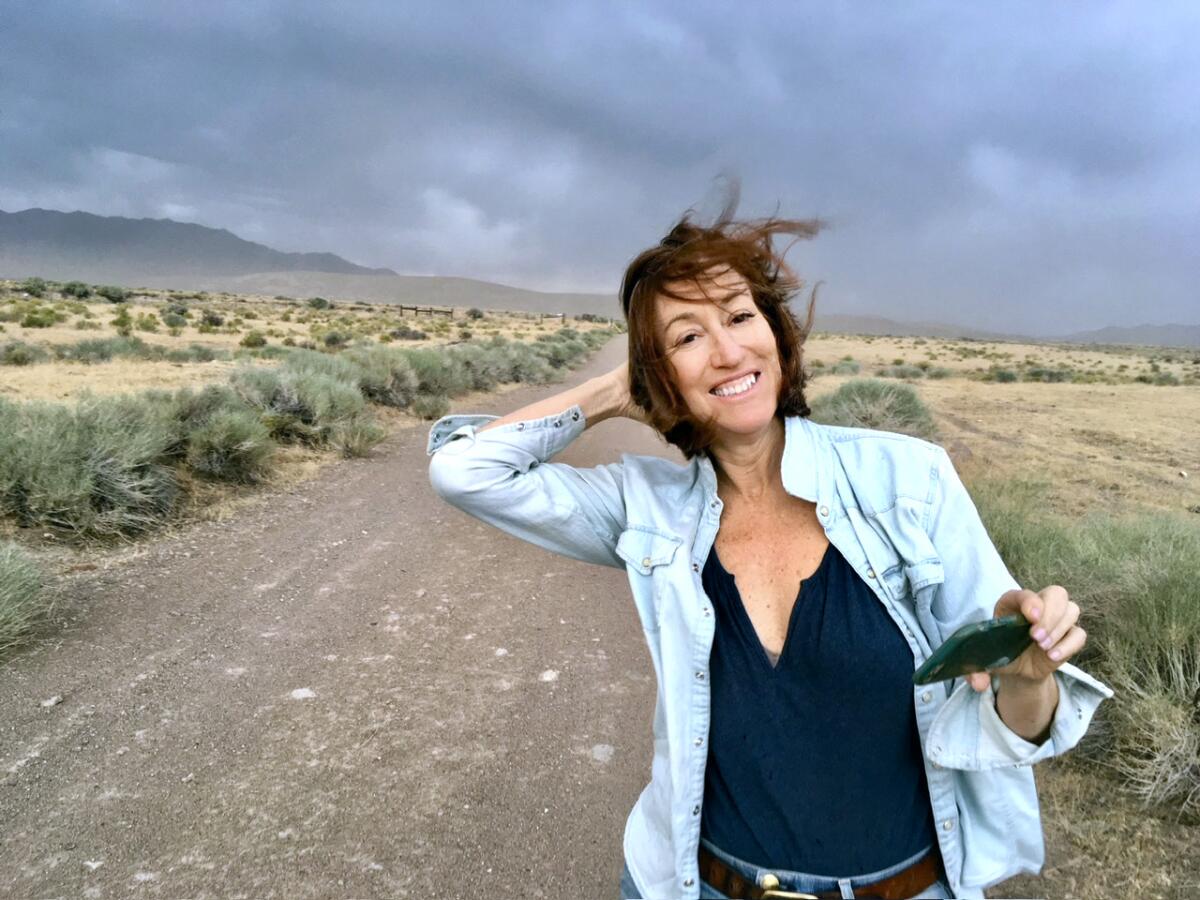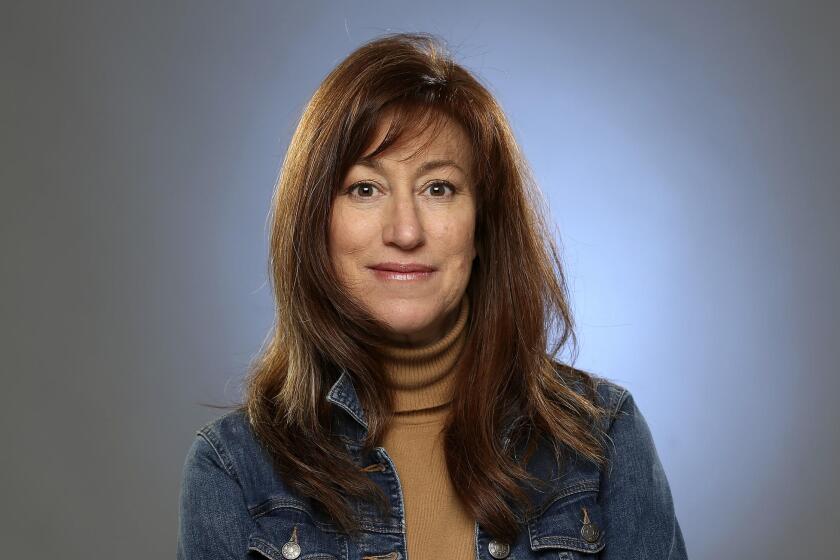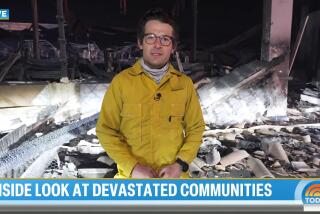Diana Marcum, Pulitzer Prize-winning former reporter for Los Angeles Times, dies

- Share via
Diana Marcum forged a career, and a life, by giving a voice to Californians whom many people didn’t take time to notice. Her favorite subjects were strivers and oddballs, the dispossessed and the people who dared to be delighted in the face of life’s struggles.
The veteran journalist chronicled drought and hunger and deep anxiety from the Central Valley, which she made her home for more than two decades. In even the darkest tales, she usually managed to deliver a ray of light.
Marcum, a former Los Angeles Times reporter who won the 2015 Pulitzer Prize for feature writing, died Wednesday night, according to her friend Janet Sluis. Marcum had a glioblastoma removed from her brain in early July, but fell into a coma shortly after surgery at Fresno Community Regional Medical Center and never fully recovered. She was 60.
The lifelong Californian left The Times late in 2022 and went in on the purchase of a second home in Portugal’s Azores — a world away from Fresno — where she had planned to write what would have been the third of her travel memoirs.
Kevin Merida, The Times’ executive editor, described Marcum as “an extraordinary writer, with a strong, resonant voice and exquisite observational skills.” He recalled a day-long tour of Central Valley farms, homes and businesses that the reporter took him on when he started his job two years ago and how there was “such respect and genuine affection for her at every stop we made.”
Carlos Lozano, a Times editor who was instrumental in bringing Marcum to the newspaper in 2011, said: “She had a big heart. She empathized with people. She loved to talk and to really listen. That humanity came across in every story.”
Marcum would be the first to say that she didn’t fit the standard journalism mold.
Born in Sonoma County on Feb. 2, 1963, Marcum and her younger brother were raised by adoptive parents in the San Bernardino County community of Loma Linda. She had a fascination with writing, and newspapers, from a young age.
By the fourth grade, she would later recall, she told her family she wanted to become a reporter for the Los Angeles Times. (Though young Diana also mused about being an English professor or perhaps toiling over her latest novel in a tiny Paris garret.)
More prosaic pursuits became a necessity when both of her parents died of cancer during her high school years. She quickly went to work — cobbling together waitressing and other odd jobs, including giving dance lessons — while attending classes at Crafton Hills College in Yucaipa.
“When I met her, she was determined to work and keep her brother out of the foster care system, which she succeeded in doing,” said Sluis, a dear friend since community college days. “Diana had the attitude that life was short, and that she wouldn’t ever really plan for the future.”
Marcum retained her ambition to be a writer and freelanced for Southern California newspapers when she could.
“I didn’t get through college. I didn’t have any of the right credentials,” she told an interviewer from the Nieman Foundation, which granted her one of its prestigious journalism fellowships for 2018. “But I could write. People seemed to think I could write.”
Marcum’s distinctive voice — spare and witty — made her irresistible to editors. She first landed a staff writing job at the San Bernardino Sun, then moved to the Desert Sun in Palm Springs. At the Fresno Bee, editors gave her ever-wider latitude as an enterprise reporter and a columnist.
Her pieces ran the gamut, from dispatches on Barack Obama’s first inauguration to a profile of a group of ice-cream-loving nuns and an ode to a taco truck that became the glue for one small mountain town.
While she initially worried about her lack of formal education, Marcum’s view evolved. “I came to see that there are advantages to having come up my own way,” she told the Portuguese American Journal. “Because I will never be writing about ‘them.’ I am a ‘them.’ I will always be writing about ‘us.’”
Her work soon attracted the attention in the metropolis to the south, where journalists recognized a compatriot who delivered deft profiles, while making no secret that she had little appetite for the crime, fires and scandals that are mainstays of the news.
“She was a pure feature writer. The way she wrote was just so gorgeous and simple and evocative,” said Steve Chawkins, himself an acclaimed writer and editor at The Times.
Weary of the daily journalism grind, Marcum took a buyout from the Bee and set off for the Azores, the Portuguese islands that had captured her fancy after she met the islands’ many Central Valley expatriates. She returned from the archipelago dead broke but with the raw material for her first book.
Lozano, then serving as state editor at the Los Angeles newspaper, quickly put her to work on a series of freelance pieces. Her restless eye captured the full pageant — from the dark secrets of the Central Valley’s canals, to the aching loss of seven soldiers who had all graduated from Clovis High School, to the intricate dance of Portuguese bullfighters. While still a freelancer, she made the front page of The Times 14 times in just one year.
Lozano pressed to give the emerging star a full-time job. But with newspapers in the midst of a prolonged hiring slump, the recruitment stalled.
When the editor finally called in 2011 to tell Marcum she had gotten a job at the paper, she laughed.
“She thought I was kidding, because she had given up all hope,” recalled Lozano. “But then I told her I wasn’t joking.”
The stories that would win her the Pulitzer Prize were classic Marcum. She didn’t propose a large “project” on the California drought — and demand months of time to do the work — but merely began talking to people in communities such as Huron, Terra Bella, Madera and Stratford.
Marcum and photographer Michael Robinson Chavez found the disaster struck haphazardly, in part because of uneven allocations from struggling water districts. That meant green crops and contented owners operated just across the way from desiccated fields and emptied farm camps.
The reporter would ease into her conversations with her subjects, so they didn’t feel like interviews, the way she engaged with Francisco Galvez, who was struggling to find work around the Fresno County town of Huron.
“It felt like they were just shooting the breeze,” recalled Robinson Chavez, whose aching black-and-white photos anchored the series. “But it wasn’t small talk. It was his pain. His agony. His seemingly stoic exterior vanished quickly as he spoke with Diana.”
Marcum laid out the 35-year-old Galvez’s desperation for work in plain prose, He needed to feed his children and put shoes on their feet. “Since the days of the Dust Bowl,” she wrote, “these have been the places where trouble hits first and money doesn’t last.”
The stories echoed John Steinbeck’s “The Grapes of Wrath,” the classic novel that one of her editors, Kari Howard, had given her when she began criss-crossing the sprawling valley in search of the story.
Marcum described how California’s great agricultural underbelly withered under cloudless skies, with vast stretches of farmland slowly sagging on top of overdrawn aquifers. Town wells cracked, while pipes spit only mud and yellow water.
The stories read like tone poems, introducing readers to the small-time pistachio grower who lovingly named, and cried over, his dying trees; a grocery store owner who measured the devastation in a growing pile of IOUs; and Galvez and a fellow field hand raking nonexistent weeds, a pantomime to convince their boss they had enough work to keep them employed.
Steve Clow, now an assistant managing editor at The Times, helped focus the stories, which then moved on to Howard for polishing. Marcum would later describe how she and Howard, who edited the Column One feature, became so melded they acted like they shared the same brain. The duo agreed that the stories were less about the drought than about “people showing hope and resilience and character during a hard time.”
Their relationship deepened when Howard was diagnosed with cancer in 2018. The reporter wrote a story about her cross-country road trip to visit her friend in 2021. (Though the deeply private Howard went unnamed.) “She was dying. She told me I needed to accept that fact before I got there so we could get on with enjoying our visit,” Marcum wrote.
The piece described America’s beautiful, tortured landscape, in the time of COVID-19, while her car stereo hinted at bigger questions. “Perhaps a better world is drawing near,” crooned Jackson Browne, “just as easily, it could all disappear.” Marcum was devastated when Howard died, at 59, early last year.
In her final months at The Times, Marcum had become, if anything, more defiant in the face of increasingly noxious politics and the worldwide pandemic. She told fellow reporters she wanted to create a novel beat — centered on joy.
One piece described a community garden in Woodlake that epitomized a Chinese proverb: “If you want 100 years of prosperity, grow people.”
Another story painted the scene of a Cambodian night market. A third sketched a onetime social worker who walked all 4,121 streets in Santa Cruz County in search of something elusive. Among the small wonders the worker discovered: “spiraling vines of wild cucumber dripping down fences and how they would bounce back like a spring if she pulled them.”
Her 11 years at the paper ended in December, with a farewell note telling her colleagues she would miss “all the vibrant things to come” at The Times, but wanted to pursue “other projects.”
Her first trip to the Azores had spawned her critically admired 2018 memoir, “The Tenth Island: Finding Joy, Beauty, and Unexpected Love in the Azores.” She had a contract to write another book on life in the archipelago, 1,000 miles southwest of Portugal.
Marcum had traveled widely but said the remote islands and their people had taken a grip on her soul. She described how she loved the languid days, active volcanoes and abundant distance from the larger world. And Marcum embraced the Portuguese concept of saudade.
“It’s an indescribable longing,” she told the Portuguese American Journal. “It’s a yearning for something that’s just out of reach — lost in the past or something you just can’t even name. It has something to do with life and death and the feeling you get gazing at the sea.”
She joined with her partner, former Fresno Bee photographer Mark Crosse, and her friend Sluis to buy a home on the island of Terceira. The couple had arrived there in mid-June. But their dream escape ended after only a couple of weeks, when Marcum collapsed.
Her travels already had confirmed Marcum’s view that the good in life deserved equal footing with the bad.
“I am resistant to giving over every sliver of attention to the ‘important’ stuff,” she told PEN America in 2018. “It’s not just that life goes on. It’s that it thrums around and beneath and despite anything and everything.”
Times researcher Scott Wilson contributed to this report.
More to Read
Sign up for Essential California
The most important California stories and recommendations in your inbox every morning.
You may occasionally receive promotional content from the Los Angeles Times.












